JB-2 Loon Video - Newsreel
|
|
JB-2 Loon
JB-2 Loon
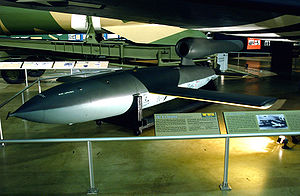
Picture - Photo of the Republic/Ford JB-2 at the National Museum of the United States Air Force.
Role: Pilotless flying bomb
National origin: United States
Manufacturer: Republic Aircraft
Willys-Overland
Ford Motor Company
First flight: October 1944
Introduced: 1945
Retired: 1950
Primaryusers: United States Army Air Forces
United States Air Force
Number built: 1,391
Developed from: German V-1 flying bomb
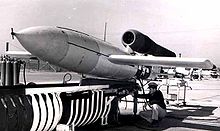
Picture - JB-2 Loon being inspected by USAAF personnel at either Eglin or Wendover AAF, 1944.
The Republic-Ford JB-2 "Loon" was a United States copy of the German V-1 flying bomb. Developed in 1944, and planned to be used in the United States Invasion of Japan (Operation Downfall), the JB-2 was never used in combat. It was the most successful of the United States Army Air Forces Jet Bomb (JB) projects (JB-1 through JB-10) during World War II. In the postwar era, the JB-2 played a significant role in the development of more advanced surface-to-surface tactical missile systems such as the MGM-1 Matador and later MGM-13 Mace.
Wartime development
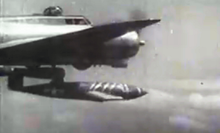
Picture - JB-2 being air launched for flight test by B-17 bomber during testing of weapon, 1944
The United States had known of the existence of a new German secret weapon since 22 August 1942 when a Danish Naval Officer discovered an early test version of the V-1 that had crashed on the island of Bornholm; in the Baltic Sea between Germany and Sweden. A photograph and a detailed sketch of the V-1 test unit V83 was sent to Britain. This led to months of intelligence-gathering and intelligence-sifting which traced the weapon to Peenemx¼nde, on Germany's Baltic Coast, the top-secret German missile test and development site.
As more intelligence data was obtained though aerial photography and sources inside Germany, it was decided in 1943 for the United States to develop a jet-powered bomb as well. The United States Army Air Forces gave Northrop Aircraft a contract in July 1944 to develop the JB-1 (Jet Bomb 1) turbojet-powered flying bomb under project MX-543. Northrop designed a flying-wing aircraft with two General Electric B1 turbojets in the center section, and two 900kg (2000lb) general purpose bombs in enclosed "bomb containers" in the wing roots. To test the aerodynamics of the design, one JB-1 was completed as a manned unpowered glider, which was first flown in August 1944.
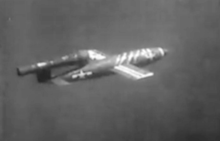
Picture - In flight after air launch, 1944
However, in July 1944, three weeks after German V-1 "Buzz Bombs" first struck England on June 12 and 13, American engineers at Wright Field, fired a working copy of the German Argus As 014 pulse-jet engine, "reverse-engineered" from crashed German V-1s that were brought to the United States from England for analysis. The reverse engineering provided the design of America's first mass-produced guided missile, the JB-2.
By 8 September, the first of thirteen complete JB-2s, reverse engineered from the material received at Wright Field in July was assembled at Republic Aviation. The United States JB-2 was different from the German V-1 in only the smallest of dimensions. The wing span was only 2½inches wider and the length was extended less than 2feet (0.61 m). The difference gave the JB-2 60.7 square feet of wing area versus 55 for the V-1.
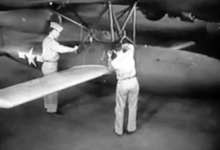
Picture - Ground preparation prior to air launch, 1944
This was the first unmanned guided missile in America's arsenal. The first launch of a JB-2 took place at Eglin Army Air Field in Florida in October 1944. In addition to the Eglin group, a detachment of the Special Weapons Branch, Wright Field, Ohio, arrived at Wendover Field in Utah in 1944 with the mission of evaluating captured & experimental rocket systems, including the JB-2. Testing was from a launch structure just south of Wendover's Technical Site. The launch area is visible on Google Earth. Parts of crashed V-1s and JB-2s are occasionally found by Wendover Airport personnel.
In December 1944, the first Northrop JB-1 was ready for launch. The missile was launched by a rocket-propelled sled along a 150m (500ft) long track, but seconds after release the JB-1 pitched up into a stall and crashed. This was caused by an incorrectly calculated elevon setting for take-off, but the JB-1 program was subsequently stopped mainly because the performance and reliability of the GE B1 turbojet engines were far below expectations. In addition the cost to produce the Ford copy of the Argus pulse-jet engine of the JB-2 was much less than the GE turbojets. Subsequently work proceeded on the JB-2 for final development and production.
An initial production order was 1,000 units, with subsequent production of 1,000 per month. However that figure as not anticipated to be attainable until April 1945. Republic had its production lines at capacity for producing P-47 Thunderbolts, so it sub-contracted the airframe manufacturing to Willys-Overland. Ford Motor Co built the engine, designated as the IJ-15-1, which was a copy of the V-1's 900-lb. thrust Argus-Schmidt pulse-jet. Guidance and flight controls were manufactured by Jack and Heintz Company of Cleveland, Ohio, and Monsanto took on the task of designing a better launching system, with Northrop supplying the launch sleds. Production delivery began in January 1945.
An envisioned 75,000 JB-2s were planned for production. A USAAF launching squadron was formed in anticipation for using the weapons both against Nazi Germany and Japan. However, the end of the European War in May 1945 meant a reduction of the number of JB-2s to be produced, but not the end of the program. Army commanders in Europe had dismissed as a weapon against Nazi Germany, as the strategic bombing concept was implemented and by 1945 the number of strategic targets in Germany was becoming limited. However, the JB-2 was envisioned as a weapon to attack Japan, especially in view of the anticipated high casualties expected in the planned invasion of Japan during Operation Downfall. A 180-day massive bombardment of the Japanese Home Islands was being planned prior to the amphibious landing of ground forces "by the most powerful and sustained pre-invasion bombardment of the war". Included in the assault were the usual naval bombardment and air strikes augmented by rocket-firing aircraft and an American version of the German "V-1 Buzz Bomb".
A navalized-version, designated KGW-1 was planned to be used against Japan from naval LSTs (Landing Ship, Tank) as well as Escort carriers (CVEs). In addition, launches from PB4Y-2 Privateer patrol aircraft were being planned and the techniques being developed. The official U.S. Air Force Fact Sheet on the JB-2 states that just before the end of the war, an aircraft carrier en route to the Pacific took on a load of JB-2s for possible use in the planned invasion of the Japanese home islands, however the name of the carrier has never been identified. In addition, according to one Eglin AFB history, an unidentified USAAF unit in the Philippines was preparing to launch JB-2s against Japan, but the Atomic Bombings negated that mission.
The use of Atomic Weapons in August 1945 against Japan led to the cancellation of Operation Downfall and the production of JB-2s were terminated on 15 September. A total of 1,391 units were manufactured.
Postwar testing
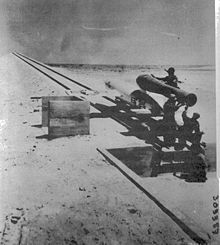
Picture - JB-2 Loon being prepared for a test launch at Holloman AFB about 1948.
The U.S. Army Air Force continued development of the JB-2 as Project MX-544, with two versions: one with preset internal guidance and another with radar control. Several launch platforms were developed, including permanent and portable ramps, and mobile launching from beneath the wings of Boeing B-17G or Boeing B-29 bombers. Testing continued from 1944 to 1947 at Eglin to improve launch and guidance.
The U.S. Navy's version, the KGW-1, later redesignated LTV-N-2, was developed to be carried on the aft deck of submarines in watertight containers. The first submarine to employ them was the SS-348 Cusk which successfully launched its first Loon on February 12, 1947, off Point Mugu, California.
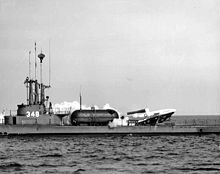
Picture - A Loon being fired from USSCusk in 1951
After the United States Air Force became a fully independent arm of the National Military Establishment (later renamed to the Department of Defense) on September 18, 1947, research continued with the development of unmanned aircraft and pilotless bombers, including the already available JB-2 and the sub-sonic, 500-mile (800 km) range XSSM-A-1 which had been specified in December 1945. The contract for developing the XSSM-A-1 was awarded to the Glenn L. Martin Company of Baltimore, Maryland and was known as the MX-771 project. The XSSM-A-1
The USAF Air Materiel Command reactivated the JB-2 as Project EO-727-12 on 23 April 1948, at Holloman AFB, New Mexico, the former Alamogordo Army Air Field. The JB-2 was used for development of missile guidance control and seeker systems, testing of telemetering and optical tracking facilities, and as a target for new surface-to-air and air-to-air missiles (ironically fulfilling the former V1's codename Flakzielgerx¤t - anti-aircraft targeting device). The JB-2 project used the North American Aviation NATIV (North American Test Instrument Vehicle) Blockhouse and two launch ramps at Holloman: a 400ft (120 m), two-rail ramp on a 3 degree earth-filled slope, and a 40ft (12 m) trailer ramp. The 40' trailer ramp was the first step toward a system which would eventually be adapted for the forthcoming Martin MGM-1 Matador, first operational surface-to-surface cruise missile built by the United States. The program at Holloman was terminated on 10 January 1949 after successful development of a radio guidance and control system that could control and even skid-land a JB-2 under the control of an airborne or ground transmitter.
The Air Proving Ground Command used JB-2s in a series of tests in the late 1940s and 1950s. In the spring of 1949, the 3200th Proof Test Group tested launching JB-2s from the wings of B-36 Bombers at Eglin AFB. About a year later, JB-2s were tested as aerial targets for experimental infrared gunsights.
In the summer of 1992, military crews uncovered the well-preserved wreckage of a JB-2 at a site on an Air Force-owned section of Santa Rosa Island. Most crash sites on the barrier island were little more than flaky rust, but after the find, officials were planning further searches.
Subsequent JB projects
The JB-3 Tiamat subsonic air-to-air missile program began in January 1944 under project MX-570. Prime contractor was Hughes who developed the Tiamat with the assistance of the NACA. JB-3 prototypes were initially launched from the ground with the aid of a booster and then from A-26 Invader aircraft. The JB-3 was propelled by a dual-thrust (boost/sustain) solid-fuelled rocket motor and had three comparatively large wings with control surfaces for stability and control. The Tiamat used a semi-active radar seeker and the warhead was triggered by a proximity fuze. Testing and development of the JB-3 continued until after World War II, but in late 1946 or early 1947, the program was eventually terminated. By that time, more promising air-to-air missile projects had been started, notably the AAM-A-1 Firebird and AAM-A-2/F-98/GAR-1 Falcon.
The JB-4, developed under project MX-607, was a basically a GB-4 guided glide bomb fitted with a Ford PJ31 pulsejet engine (the same type as used in the JB-2) to extend the standoff range to 120km (75 miles). Like the GB-4, it was equipped with an AN/AXT-2 TV transmitter, sending its TV camera image to an operator in the launching aircraft, who could send radio commands to change the course of the missile. The JB-4 is reported as a surface-to-surface missile in some official records, so it seems that is was also intended for ground launch. The missile was tested in 1945, but the program was canceled at the end of World War II.
The JB missiles #5, #6, #7 and #9 were all cancelled in the design or concept phase before anything was built. The JB-5 (project MX-595) was to be a wingless unguided air-to-surface rocket with a range of 6km (3.7 miles), while the JB-6 (project MX-600) was planned as a spin-stabilized supersonic air-to-surface guided missile. The JB-7 (project MX-605) is described as a 4400kg (9700lb) turbojet-powered surface-to-surface cruise missile with a range of 640km (400 miles). Interestingly, the USAAF reference [5] attributes the JB-7 designation to a project for a jet-powered high-speed research aircraft, which was cancelled when no suitable design came forward. However, given the scope of the JB-series, this seems to be an error. The JB-8 designation was briefly assigned to the MX-606 project for a surface-to-air guided missile. It is described under its later designation SAM-A-1 GAPA (Ground-to-Air Pilotless Aircraft). The designation JB-9 was reserved for a short-range surface-to-surface missile, but this project was most likely never actually started. The JB-9 project is probably identical to project MX-626, which is documented as a "jet-propelled short-range surface-to-surface guided missile".
After the Northrop JB-1 program had been terminated because of the failure of the turbojets, the remaining built JB-1s were modified to a pulsejet-powered configuration, designated JB-10. A single Ford PJ31 pulsejet engine was mounted in a centerline shroud. The latter was of larger diameter than the pulsejet to allow the flow of cooling air around the engine. The prominent bomb containers of the JB-1 were also removed and replaced by integral warhead sections in the wing roots. Like the original JB-1 (and also the JB-2), the JB-10 was to be a low-precision standoff weapon for the planned invasion of Japan. The missile used a simple preset guidance system, where it would fly a predetermined distance into the direction of launch and then dive to the ground. The first flight of a JB-10 occurred in April 1945, but was not successful. In fact, of the 10 test-launches of JB-10s there were eight failures and two only partial successes. Because of the development problems (caused by several components of the system) and because the need for such a weapon had disappeared, the JB-10 program was terminated in January 1946.
JB-2 survivors
National Museum of the United States Air Force, Dayton, Ohio
U.S. Air Force Armament Museum, Eglin AFB, Florida
Evergreen Aviation & Space Museum, McMinnville, Oregon
(Engine only, operational) Planes of Fame air museum, Chino, California[1]
A JB-2 is on open-air display at the Museum of Alaska Transportation and Industry in Wasilla, Alaska.
Museum of Transport and Technology (MOTAT), Auckland, New Zealand
Hill Aerospace Museum, Hill AFB, Utah has an original JB-2, "Wendover Willie" [2]
Point Mugu Missile Park, on open-air display at Naval Air Station Point Mugu, California.
Cradle of Aviation Museum, Garden City, New York.
Related development
V-1 (flying bomb)
Comparable aircraft
Interstate XBDR
McDonnell LBD Gargoyle
This article incorporates public domain material from websites or documents of the Air Force Historical Research Agency.
National Museum of the USAF JB-2 LOON Fact Sheet
Mindling, George, and Bolton, Robert, 'U.S. Air Force Tactical Missiles 1949-1969 The Pioneers', 2008, Lulu Press
Living Warbirds: The best warbirds DVD series.
Source: WikiPedia